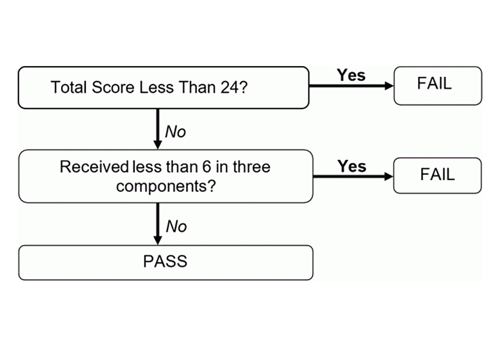FRCR Part 2B (Radiology) - CR2B - scoring system
LEARN MORE1 Context
The Final FRCR (Part B) Exam consists of four scoring components; two orals a reporting session and a rapid reporting session. The resultant sets of marks are considered as a whole to generate a pass or fail. There is no concept of passing one part (e.g. orals) only. There is no ranking of candidates, other than for the purpose of determining the recipient of the Gold Award as described below.
2 Preparation
In advance of each exam sitting, the Senior Examiners meet to agree marking schemes for the sets to be used in the reporting and rapid reporting sessions. All examiners will have prepared their images for the oral assessment in advance, with guidelines on the features and scoring.
3 Scoring
3.1 Rapid Reporting
Candidates report on 30 images and have the opportunity to attain two marks per image, so a maximum of 60 marks. Candidate responses are double marked for QA purposes with any adjudication required provided by the Senior Examiner.
Marks are allocated as shown below (dependent upon the type of image):
|
Image type |
Candidate response |
Mark |
|---|---|---|
|
Normal Image |
Correctly classified |
+2 |
|
|
Incorrectly classified (false positive) |
0 |
|
|
No answer given |
0 |
|
Abnormal Image |
Correctly classified and correctly identified |
+2 |
| Correctly classified with partially correct answer | +1 | |
|
|
Correctly classified but incorrectly identified |
0 |
|
|
Incorrectly classified (false negative) |
0 |
|
|
No answer given |
0 |
Following the marking exercise each candidate will have a score between 0-60. An overall rapid reporting mark is then awarded on the basis of total marks achieved using the scale below:
|
Total marks |
Overall mark |
|---|---|
|
00 - 48 |
4 |
|
49 |
4.5 |
|
50 - 51 |
5 |
|
52 - 53 |
5.5 |
|
54 |
6 |
|
55 - 56 |
6.5 |
|
57 - 58 |
7 |
|
59 |
7.5 |
|
60 |
8 |
3.2 Reporting
Candidates report on six cases and have the opportunity to attain a maximum of 8 marks for each case, so a maximum of 48 marks. Candidate responses are double marked for QA purposes with any adjudication required provided by the Senior Examiner.
Marks are allocated to each case as shown below:
|
Candidate response |
Mark |
|---|---|
|
No answer offered |
3 |
|
Fail: significant observations missed; correct diagnosis not made |
4 |
|
Borderline: appropriate if there are two main diagnoses in the case but only one is mentioned; some observations missed |
5 |
|
Pass: most observations made correctly; principal diagnoses correct |
6 |
|
Good Pass: additional relevant material included in a "pass" grade answer |
7 |
|
Excellent: a perfect answer, clear and confident |
8 |
Following the marking exercise each candidate will have a score between 18 and 48. An overall reporting mark is then awarded on the basis of total marks achieved using the scale below:
|
Total marks |
Overall mark |
|---|---|
|
18 - 25 |
4 |
|
25.5 - 28 |
4.5 |
|
28.5 - 31 |
5 |
|
31.5 - 34 |
5.5 |
|
34.5 - 37 |
6 |
|
37.5 - 40 |
6.5 |
|
40.5 - 43 |
7 |
|
43.5 - 46 |
7.5 |
|
46.5 - 48 |
8 |
3.3 Orals
Candidates are scored on images shown by two pairs of examiners and have the opportunity to attain a maximum of 8 marks from each pair.
Marks are allocated from each pair as shown below:
|
Performance Description |
Comments |
Score |
|
Very Poor Answer |
Key findings missed even with help Wrong or dangerous diagnosis |
4 |
|
Poor Answer |
Slow to spot abnormality Poor differential diagnosis Needed help to get correct answer |
5 |
|
Principal findings seen |
Some abnormalities seen with help Principal diagnosis correct Limited differential |
6 |
|
Good Answer |
Key findings spotted quickly Correct deductions made and correct diagnosis Good differential offered |
7 |
|
Excellent answer – all findings seen |
Correct diagnosis and deductions No errors Succinct/accurate report Excellent differential |
8 |
Half marks may be awarded.
4 Pass mark
Following the compilation of marks each candidate will have a score of 4-8 in each component of the exam (two orals, the reporting session and the rapid reporting session). The pass mark in each component is 6, making the overall pass mark 24.
In addition to achieving a score of 24 or above, candidates must obtain a mark of 6 or above in a minimum of two of the four components (i.e. candidates must not have a score of less than 6 in three components). Any candidate not achieving 6 or above in two or more components will be deemed to have failed the exam even if the required score of 24 is attained overall.
5 Exam Pass / Fail Decisions
In order to determine the outcome of the exam the following criteria will be applied to each candidate’s scores:

6 The Gold Award
It can be awarded to an outstanding candidate on recommendation of the Examining Board, based on performance, at each sitting of the exam.
To be considered for the Award, a candidate must be making their first attempt at the exam and have obtained the highest score overall. In the event of a tie, the candidate with the highest scores in the oral component will be the recipient of the Award.
Our exams
Find out more about our FRCR exams in clinical radiology and clinical oncology, and DDMFR exams in dental and maxillofacial radiology.
